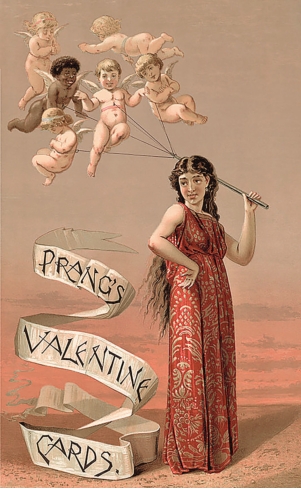
Although the tradition of giving valentines dates back to medieval England, it was not until the 1860s that multicolored romantic greeting cards were mass produced by machine, thanks to Boston printer Louis Prang.
Louis Prang Street in the Fenway is named after the German emigrant, Prang, who perfected the chromolithographic process, which involves transferring colored lithographic ink drawings directly onto stones which are then pressed onto paper.
Prang was able to print up to 20 colors onto his valentines. Before that, multicolored prints were hand drawn.
Prang was born in Breslau, Germany in 1824. When he was young, he became an apprentice to his father and learned engraving and printing techniques.
Prang began traveling in Europe, working in printing and textile shops in the early 1840s. Because he became involved in German revolutionary activities in 1848, he was pursued by the Prussian government and he fled to the U.S. in 1850, settling in Boston.
Prang and a partner created a Bostonbased printing company that specialized in lithographic prints of buildings and towns in Massachusetts. He bought his partner’s shares in 1860 and created L. Prang and Company, which became known for maps of Civil War battle locations.
In
1864, Prang went to Europe to learn about German lithography, returning
a year later to create reproductions of major art works. He also began
producing a series of popular album cards that displayed both natural
scenes and patriotic symbols.
Company
records indicate that Prang was manufacturing and selling valentines as
early as January 1868. However, he is more well-known as the “Father of
the Christmas Card.” He exported Christmas greeting cards in 1874,
distributing them in the U.S. the following year, and sold five million
Christmas cards annually by 1882.
Prang
also worked to improve art education in the U.S. by publishing
instructional books, creating a color wheel and establishing a
foundation to train art teachers.
L.
Prang and Company merged with another business to become the
Taber-Prang Company in 1897 and moved to Springfield, Massachusetts.
Prang died in Los Angeles on vacation in 1909.
While
Prang popularized the use of chromolithography for valentine production
in the U.S., he was not the country’s first distributor of valentines.
Among
greeting card aficionados, Esther Howland is recognized as the “Mother
of the American Valentine.” Howland became interested in creating
handmade valentines in 1849, after she received one from her father’s
business associate at her Worcester home.
She
convinced her father, who owned the largest book and stationery supply
store in Worcester, to order lace paper and other supplies from England
and New York City.
She
made a dozen sample cards, which her brother added to his inventory for
his next sales trip. Hoping for as much as $200 in orders, Howland’s
brother returned with more than $5,000 in advance sales. Through both
industry and word-of-mouth advertising, she developed a $100,000
business, which she sold in 1881 to care for her ailing father.